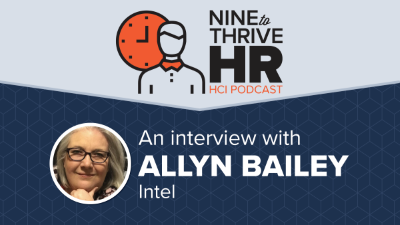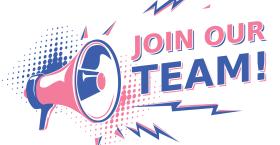Backstage with Allyn Bailey: Q&A with a 2020 Strategic Talent Acquisition Conference Speaker
In 2020, HCI hosts the 2020 Strategic Talent Acquisition Conference where event attendees will learn how to demolish barriers between employers and top talent. If you find yourself examining your own talent acquisition processes and wondering why you still do things the same way your predecessors did, you'll fit right in at this event.
In the meantime, we had a chat with Allyn Bailey, Talent Acquisition Transformation Program Manager at Intel Corporation. Allyn will be presenting Pipelines over Req's: Intel's New Approach to Talent Acquisition on Day 2 of the conference. She recently joined us on our podcast, Nine to Thrive HR, to give a sneak peek into how Intel is breaking down talent acquisition barriers to build real connections.
Organizations are still fighting the war for talent. What does this look like from your perspective at Intel?
ALLYN: The biggest thing we’re seeing in the talent marketplace is that while people have always had more choices in where they want to work, they’re really starting to realize it. It’s changing the way companies look to attract talent and the way in which the talent is looking at work itself. People are starting to realize that as an individual, they have more control and more of a say in what their employee experience is going to be.
For Intel, that’s forced us to be very pragmatic about examining the way we talk about the work we have available. We can talk about why we’re so awesome, but we also have to talk about why we’re the right place for each individual. We can get them in the door, we can get them to apply. That’s not a problem—our name brand helps with that. But engaging, involving, and moving candidates to where we land them in the right opportunities has become more complicated, because what they’re expecting from us has changed.
It’s about making a much more personalized connection with people than we’ve had to do before. We have plenty of applications, but candidates are much more interested in understanding how they fit and how we’re going to use what they bring to the table. They’re not just showing up on day one and finding out what the job is going to be.
Register Now | 2020 Strategic Talent Acquisition Conference
What are some specific things Intel is doing to address these challenges?
ALLYN: The fundamental piece for us was taking a step back and examining how talent acquisition has historically been operating—not just for us, but across industries. It’s backwards! We’ve been trying to get people to understand how they fit to us, rather than looking at people to see how we can fit to them. We’ve had to move away from talent acquisition as a transactional process to one that focuses on relationships. At Intel, we believe it’s about people and connections. It’s about building those relationships. That meant really overhauling the way we do things from end to end.
For example, how do we change the dialogue when we are out doing recruitment marketing? We can’t focus so much on telling you how fabulous we are. We have to change the dynamic of the conversation to say, “Please come tell us who you are.” It’s ridiculous to assume candidates are going to understand your company well enough to know how they will fit in. Instead, we want to know about you and get enough data and information about you so we can connect you to the right opportunity. We want to know more about what you’re aspiring to and what your experiences are.
Explore | People Analytics for HR Certification Program
That is the fundamental difference. We take the onus off individuals to be responsible for figuring out how they fit, sorting through 50 million job ads that may be on the job board, or trying to look at a career marketing site and figure out which of these 50 jobs might be right. We want candidates to let us do a better job of using our insights, technology, and matching capabilities to align them with the right opportunities.
That sounds a little bit like online dating!
ALLYN: The concept of dating is a great analogy. Let’s say you find an interesting profile and meet a person for coffee. You’re opening a conversation, providing bits and pieces of information about who you are and receiving similar information from the other person. It’s a give and take, whether the date lasts just for coffee or becomes a bigger relationship.
We believe the process for talent acquisition should be similar. It’s okay if you want to browse through our job site and apply to 50 requisitions. Go ahead. But we don’t recommend you do that. That’s not the experience we want you to have or the relationship we want to build with you. That’s why we encourage all of our candidates to join our talent network.
How does Intel's talent network change the acquisition process?
ALLYN: When you join the network, we can engage in a dialogue with you. We share pieces of information about us and you can screen yourself in or out based on that information. We’ll also ask you to tell us about yourself over time, just like you would when building any sort of relationship. We believe it’s a long game, not a short game.
As you tell us about yourself, we get better at using that information. Not for nefarious purposes, but to build valuable connection opportunities. That helps us help you find the right opportunities at Intel. It’s matchmaking.
It is a huge paradigm shift. If we’re focused on the long game, we’re managing relationships with individuals for the lifetime of their career. We don’t screen out; there is nobody who is not worthy of being in our talent pipeline.
Read the Research | How High Performing Organizations Compete for Talent
Come one, come all! It’s not about who is in the pipeline, but how we manage that pipeline. Some people today are great fits for opportunities I have today. As the company evolves and grows, someone who may not look like a great match today might be a fabulous fit in two years. They’re growing and evolving too. People, jobs, and opportunities are dynamic.
It doesn’t mean everybody gets the white glove treatment all the way through the process. But we want our candidates to know that we value them as individuals, and we hope they value Intel as an organization. We want to stay connected, to learn what you learn, to know what’s new and changing in your world. And we think we’ll get more value out of this strategy rather than starting from scratch every time we need to hire a new person.







